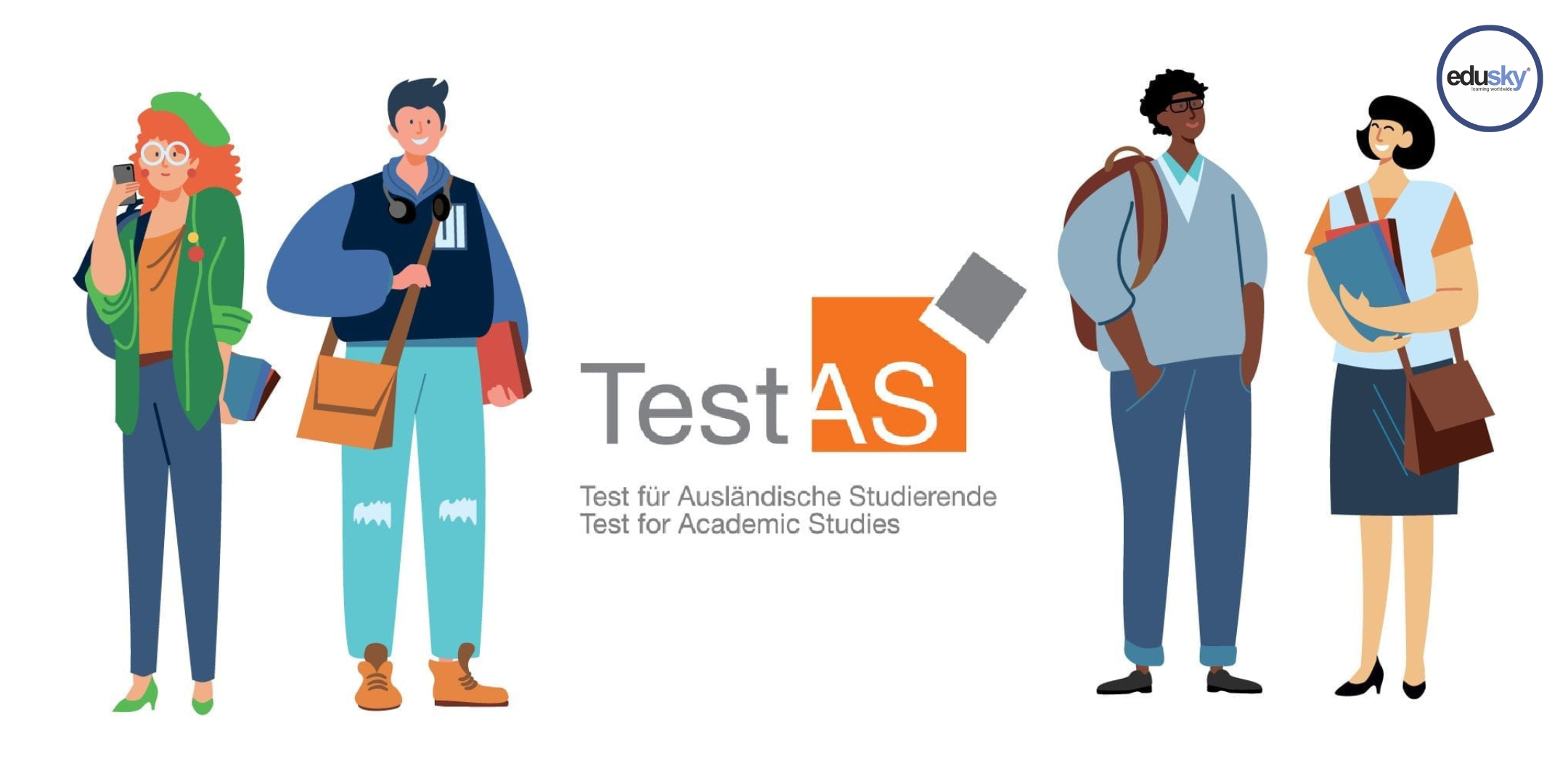All About TestAS
The first thing that comes to our mind while looking for the eligibility criteria of universities abroad is their examination. We are utterly confused when it comes to the tests to get into a University abroad. The preparation, the sample papers, the language or the method of the test all of these are the major points that we feel somewhere missing in our information. So, if you are looking for the perfect guide to help you with getting into the universities abroad then you are at the right place and TestAS is one of the major aptitude tests to study in Germany for the students of non European countries.
TestAS is an aptitude test offered by Gesellschaft für Akademische Studienvorbereitung und Testentwicklung e.V. (g.a.s.t.= Society for Academic Study Preparation and Test Development, a Registered Association). This examination is for foreign applicants from outside European countries who want to pursue undergraduate degrees at German universities. It is taken to assess intellectual abilities especially relevant to the course of your studies. But it doesn’t need that much technical knowledge of the studies that you are opting for. Neither does it measure your personality or any other aspect of your personal traits and information.
The items of TestAS are developed by ITB Consulting, Bonn. It is administered all over the world by the TestDaF Institute, Bochum.
TestAS is highly supported and encouraged by the German Academic Exchange Service (DAAD) and the German Federal Ministry for Education and Research.
Who can take the test?
TestAS is majorly for the applicants planning to pursue their one of the first degrees in Germany. There are no age restrictions,i.e. anyone from any age group can take part in. If you are wondering in your last year in secondary school if you should take the test or not? Then yes you can actually take it right now. But you should not take the test below your secondary school.
Where can one take the test?
The TestAS aptitude test can only be taken in licensed test centers. The TestDaF test centers mostly offer TestAS. You can find all test centers at Test Centers Worldwide and Test Centers in Germany on their official website. Also the core test and subject-specific tests are paper-based tests.
When can one take the test?
The test happens twice a year. For the registration you need to check the website and the relevant dates given there for the examination and registration.
This year, the next test will be conducted on 22 June 2022. The registration for this examination date has started on 18th May 2022 and will be open till 9th June 2022.
Subject covered in the test?
The Core Test consists of abilities which are relevant for all. And the Subject-specific Test measures abilities particularly related to the courses you are interested in and its particular areas of study.
There are 4 modules from which you have to choose one. They are :
- Economics
- Engineering
- Humanities, Cultural Studies and Social Sciences
- Mathematics, Computer Science and Natural Sciences
How to prepare for the test?
The test is not to assess the knowledge you have about certain subjects but TestAS measures cognitive abilities in general. There is no short-term training or course to help you score better and acquire knowledge. All you can do is try to take as many test series as possible. The official website provides you with some sample tests or test format, which we strongly recommend you to include in your preparation.
Is the test conducted in English or German?
You can choose the language in which you are comfortable. It is generally either in German or English. While choosing a language you will need at least a level B1 of the Common European Framework of Reference for that Language in order to attain a good mark in the TestAS.
In case you want to check your language skills you can apply for other language certification or register for onSET or TestDaF. You can see what your level is and all the aspects where you can improve yourself and become better everyday.
Is there any German language proficiency requirement?
The language proficiency requirements are for both the languages (English and German). A minimum B1 language skills in German or English are required to take the examination. TestAS is, however, somewhat difficult for B1-level students as you will be able to clear the basics but in terms of comprehensive questions you will not be able to score as high as it is required to score there for an above average score. As all of us know, the more we know the more it is easier for us to be conceptually clear of something. The more you increase your vocabulary the easier it gets for you to answer the questions. B1 level language skills are therefore sufficient for some of the basic subtests that involve mostly symbolic or visual understanding of charts and diagrams. But for the broader perspective this may become a barrier between you and your desired score. For example, the reading and comprehension section of the test, which has complex materials and requires your ability to conclude easily from what you read. From this section they will be keeping an eye on your word fluency and linguistic intelligence.
It really doesn’t matter if your studies are in English or German, it is better for you if you take care of them both as a professional language. You can look for certifications and fluency tests to check your language skills. Remember the language can easily increase or decrease your chances of getting higher marks!
What is the cost of the test?
The cost of this aptitude test is around 80 Euros. But you will get to know the exact fee at the time of your registration for TestAS. You can pay the fees of the TestAS either by credit card or direct debit. There is a precondition for the direct debit payments is an account with a German bank or savings bank. Notwithstanding the above, g.a.s.t. may enable payments to be made directly at the test centers. The payments and transactions by the candidates shall be processed within two working days. The financial transactions shall be conducted via Heidelberger Payment GmbH, Vangerowstraße 17, 69115 Heidelberg, Germany.
All transactions are encrypted by the latest SSL-128-bit encryption standards. The candidate’s credit card will be debited with the fees immediately after the booking has been processed. All candidates are required to print out and keep all related transaction data along with the General Terms and Conditions of Business.
How long does it take to get the result?
You can check your results about four weeks after the test. Simply by logging in to your account with your TestAS username and password in the TestAS official website. No special notifications or emails will be sent to you for this. When the results are uploaded you will get a sample of the certificate that can be viewed.
The moment you send your examination certificate or your participant ID number and your date of birth to the university, the university will verify your certificate at that time or sometimes later by logging into the website of TestAs for universities. Physical authentication of the copies are not required. And in terms of the validity of the certificate it is unlimited.
Questions Patterns and Sample Papers
Core Test
| Sub tests | Amount of tasks | Working time allotted |
| Solving Quantitative Problem | 22 | 45 minutes |
| Inferring Relationships | 22 | 10 minutes |
| Completing Patterns | 22 | 20 minutes + 5 minutes to read instructions |
| Continuing Numerical Series | 22 | 25 minutes + 5 minutes to read instructions |
| Total working time | 110 minutes |
- The subtest “Solving Quantitative Problems” has practical problems to be solved using basic arithmetic operations. This test measures your mathematical ability. The level of arithmetic problems to be solved are of elementary level.
Sample Question 1: difficulty level high
A bottle X is filled entirely with orange juice. It contains 1 l of orange juice. Maria pours orange juice from this bottle X into two empty bottles Y and Z. Bottle Y is half as big as bottle X (in terms of volume). After the filling operation, bottle X still contains 0.6 l of orange juice; bottle Y is 1/5 full of orange juice; and bottle Z is half-full of orange juice. Maria fills bottle Z with water until the bottle is full. How much liquid does bottle Z contain?
(A) 0.1 l
(B) 0.3 l
(C) 0.4 l
(D) 0.6 l
Sample Question 2: difficulty level medium
Dora and her three siblings Anton, Berta and Carl are an average of 5 years old. Anton is 2, Berta 6 and Carl 7. Dora, her cousin Hanna, Hanna’s brother Emil (18), Hanna’s sister Franka (6) and Hanna’s brother Gustav (1) are an average of 10 years old. How old is Dora’s cousin Hanna?
(A) 5
(B) 10
(C) 15
(D) 20
- In the subtest “Inferring Relationships” section of the TestAS. Here this test measures logical linguistic thought. Candidates have to identify meaning, and understand, generalize and abstract to find the relation in between. Eventually the rule will fill the gaps in between.
Sample question 1: difficulty level medium
thick : thin = ______ : ______
(A) tired – sleepy
(B) sad – happy
(C) warm – hot
(D) hungry – thirsty
Sample question 5: difficulty level high
diversity : ______ = ______ : action
(A) uniformity – success
(B) distance – passiveness
(C) variety – deed
(D) uniformity – measure
- In this next subtest of TestAS “Completing Patterns”,lines, circles, quadrilateral and other geometrical shapes are here structured as a problem and there is a common rule in between them. Your job is to find the rule to fill in the gaps in between. This test measures logical graphic ability.
Sample question 1: difficulty level high

(Image source:https://refugees.testas.de/wp-content/uploads/2016/04/TestAS_Modellaufgaben_englisch_2017.pdf)
- The next subtest of TestAS“Continuing Numerical Series” has a series of numbers designed according to a specific rule. You have to find the pattern and the missing number there. This test measures logical numerical abilities and your basic arithmetic.
Sample question 1: difficulty level low
25 35 15 45 5 55 ?
Sample question 4: difficulty level medium
2 6 16 64 640 644 ?
Sample question 6: difficulty level high
6 18 0 24 -6 30 ?
The above mentioned category is for the core test of the testAS examination. The core section is typically needed in all the studies you want to pursue further. But the other section which is named as the subject-specific test is regarding what course the student wants to pursue further.
The following are the subject-specific test categories:
- Humanities, Cultural Studies and Social Sciences Module, (which has subtests like Understanding and Interpreting Texts, Using Representation Systems, Recognising Linguistic Structures)
- Engineering Module,(which has subtests like Formalising Technical Interrelationships Visualising Solids, Analysing Technical Interrelationships Mathematics)
- Computer Science and Natural Sciences Module, (which has subtests like Analysing Scientific Interrelationships, Understanding Formal Depictions) and
- Economics Module, (which has subtests like Analysing Economic Interrelationships, Analysing Processes)
Which Subject Specific Module Should I Choose For My Studies?
Now I think you are wondering about which subject specific subtest category to choose for your subject? Here we have all the subjects and their relevant modules mentioned below.
Humanities, Cultural Studies and Social Sciences Module:
- German language and literature
- Linguistics
- Sociology
- Politics
- Philosophy
- Historical science
- Law
Engineering Module:
- Mechanical Engineering
- Electrical Engineering
- Mechatronics
- Civil Engineering
- Automotive Engineering
- Environmental Engineering
- Chemical Engineering
Computer Science and Natural Sciences Module:
- Physics
- Chemistry
- Mathematical Science
- Computer Science
- Psychology
- Pharmacology
- Medicine
Economics Module:
- Business Economics
- Political Economics
- Management
- Business Management
- Education Management
- Energy and Water Management
What is the grading scale like (is it pass/fail, percentage, score etc.?)
The results are assessed by using a test scale which has a mean of 100 and a standard deviation of 10. The test takers are generally placed between 70-130 in the test scale. And the standard deviation is between 90-110 showing the average performance. The standard deviation of the test helps us to compare each test score.
TestAS will give you a differentiated certificate in which your achievements in the subtest in points, percentile ranks and standard values are indicated. All of the candidates appear for the same and the universities will get to know about the results.
The certificates won’t show pass or fail. TestAS has no minimum score and thus it has no pass mark. The German universities will be using the ranking list of the test results for their selection of applicants at their universities.
For complete guidance and counseling for your studies abroad, contact Edusky today, call +919266405050 or Whatsapp +919871300955.




Leave a Reply